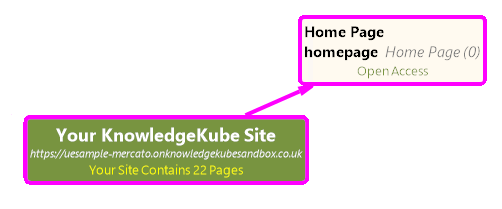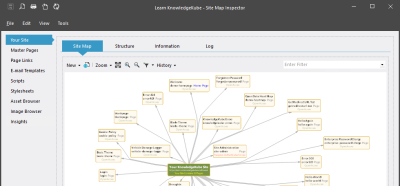In the context of Content Delivery, the term Page refers to an individual web page that forms part of a site's overall structure. In addition to static content, pages can be used to host KnowledgeKube applications, assets, and other types of element used to generate dynamic content.
The Elements that generate dynamic content are discussed in more detail in Appendix: Stand-alone Element Types and Appendix: Wrap-around Element Types.
To maintain a site's pages, click the Content Delivery icon in the main KnowledgeKube window, then use the Site Map tab situated in the Your Site panel of the Site Map Inspector. Every page is attached to the Node of either the site root or another page.
Each page is identified by a unique Virtual Page Name, which determines the page's URL based on the site's domain. For example, if your site is located at http://www.website.com/ and you add a page with the virtual page name new-page, the URL for this page will be http://www.website.com/new-page/. If you then attach a second page to the first, giving it the virtual page name another-page, the URL of the second page will be http://www.website.com/new-page/another-page/.
Before you can add a new page to your site, you must left-click the node you want to attach it to. This will cause the chosen node and any dependent nodes to become highlighted.

The site node and a dependent page node, both highlighted.
To learn how to create and modify your site's pages, refer to the following topics:
| Description | Further Reading |
|---|---|
| Create a web page based on one of several templates. | Creating a Page |
| Modify a web page's properties. | Editing a Page |
| Remove a web page from your site. | Deleting a Page |

